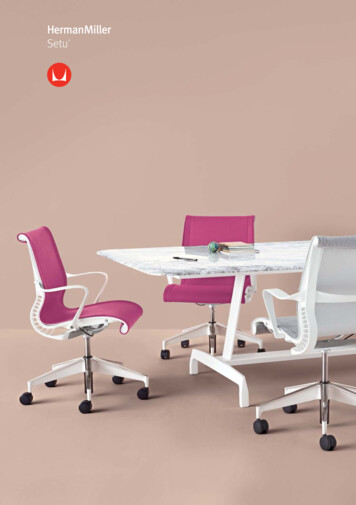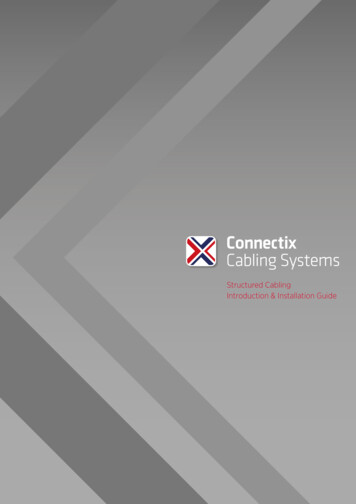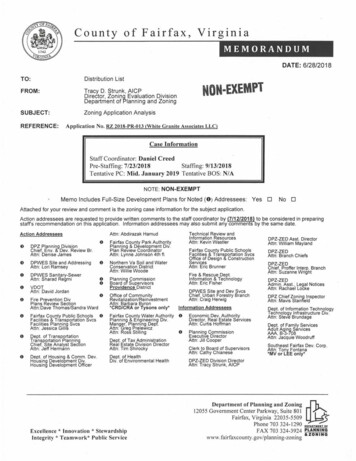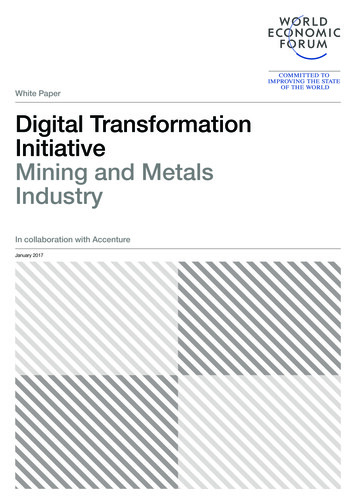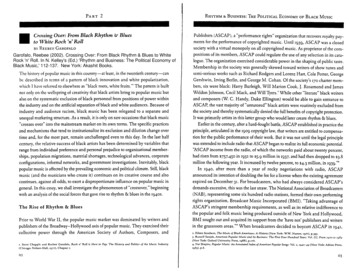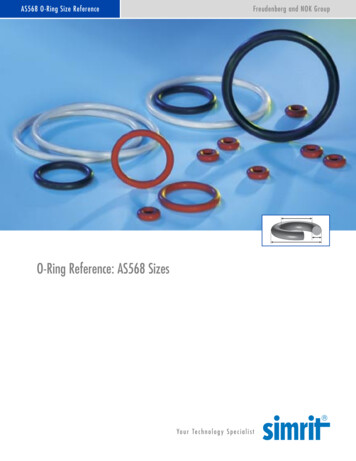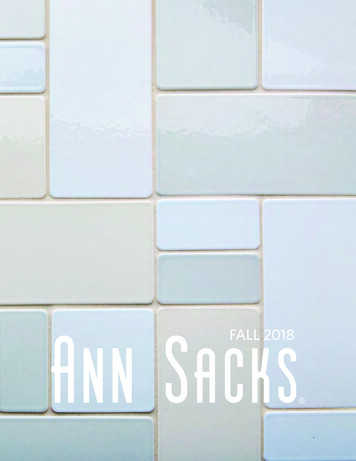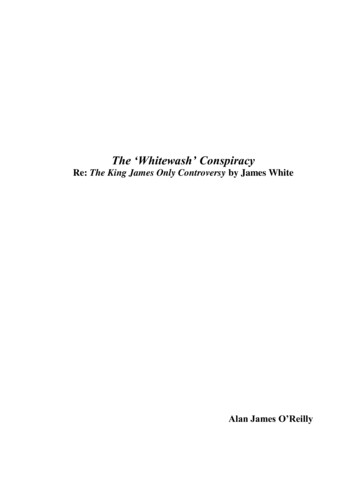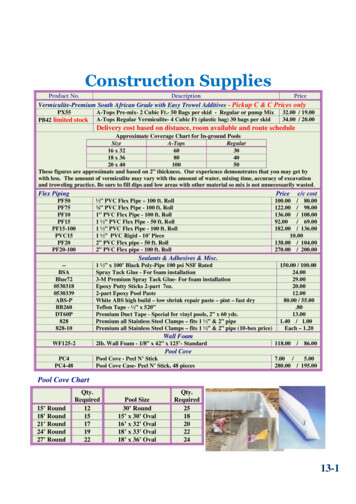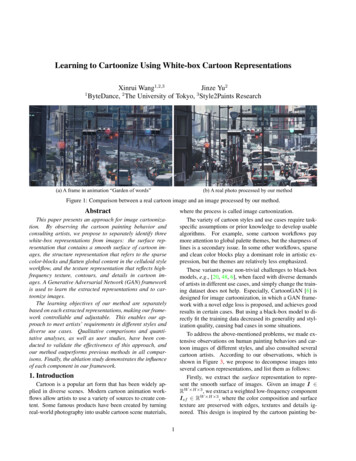
Transcription
Learning to Cartoonize Using White-box Cartoon RepresentationsXinrui Wang1,2,3Jinze Yu21ByteDance, 2 The University of Tokyo, 3 Style2Paints Research(a) A frame in animation “Garden of words”(b) A real photo processed by our methodFigure 1: Comparison between a real cartoon image and an image processed by our method.Abstractwhere the process is called image cartoonization.The variety of cartoon styles and use cases require taskspecific assumptions or prior knowledge to develop usablealgorithms. For example, some cartoon workflows paymore attention to global palette themes, but the sharpness oflines is a secondary issue. In some other workflows, sparseand clean color blocks play a dominant role in artistic expression, but the themes are relatively less emphasized.These variants pose non-trivial challenges to black-boxmodels, e.g., [20, 48, 6], when faced with diverse demandsof artists in different use cases, and simply change the training dataset does not help. Especially, CartoonGAN [6] isdesigned for image cartoonization, in which a GAN framework with a novel edge loss is proposed, and achieves goodresults in certain cases. But using a black-box model to directly fit the training data decreased its generality and stylization quality, causing bad cases in some situations.To address the above-mentioned problems, we made extensive observations on human painting behaviors and cartoon images of different styles, and also consulted severalcartoon artists. According to our observations, which isshown in Figure 3, we propose to decompose images intoseveral cartoon representations, and list them as follows:Firstly, we extract the surface representation to represent the smooth surface of images. Given an image I RW H 3 , we extract a weighted low-frequency componentIsf RW H 3 , where the color composition and surfacetexture are preserved with edges, textures and details ignored. This design is inspired by the cartoon painting be-This paper presents an approach for image cartoonization. By observing the cartoon painting behavior andconsulting artists, we propose to separately identify threewhite-box representations from images: the surface representation that contains a smooth surface of cartoon images, the structure representation that refers to the sparsecolor-blocks and flatten global content in the celluloid styleworkflow, and the texture representation that reflects highfrequency texture, contours, and details in cartoon images. A Generative Adversarial Network (GAN) frameworkis used to learn the extracted representations and to cartoonize images.The learning objectives of our method are separatelybased on each extracted representations, making our framework controllable and adjustable. This enables our approach to meet artists’ requirements in different styles anddiverse use cases. Qualitative comparisons and quantitative analyses, as well as user studies, have been conducted to validate the effectiveness of this approach, andour method outperforms previous methods in all comparisons. Finally, the ablation study demonstrates the influenceof each component in our framework.1. IntroductionCartoon is a popular art form that has been widely applied in diverse scenes. Modern cartoon animation workflows allow artists to use a variety of sources to create content. Some famous products have been created by turningreal-world photography into usable cartoon scene materials,1
Surface RepresentationStructure RepresentationReal-World Photos& Cartoon ReferencesCartoonized Results:DecomposeTexture Representation:LearningFigure 2: A simple illustration of our method. Images aredecomposed into three cartoon representations, which guidethe network optimization to generate cartoonized photos.havior where artists usually draw composition drafts beforethe details are retouched, and is used to achieve a flexibleand learnable feature representation for smoothed surfaces.Secondly, the structure representation is proposed to effectively seize the global structural information and sparsecolor blocks in celluloid cartoon style. We extract a segmentation map from the input image I RW H 3 andthen apply an adaptive coloring algorithm on each segmented regions to generate the structure representationIst RW H 3 . This representation is motivated to emulate the celluloid cartoon style, which is featured by clearboundaries and sparse color blocks. The structure representation is of great significance for generating the sparsevisual effects, as well as for our method to be embedded inthe celluloid style cartoon workflow.Thirdly, we use the texture representation to containpainted details and edges. The input image I RW H 3 isconverted to a single-channel intensity map It RW H 1 ,where the color and luminance are removed and relativepixel intensity is preserved. This feature representation ismotivated by a cartoon painting method where artists firstlydraw a line sketch with contours and details, and then applycolor on it. It guides the network to learn the high-frequencytextural details independently with the color and luminancepatterns excluded.The separately extracted cartoon representations enablethe cartooniaztion problem to be optimized end-to-endwithin a Generative Neural Networks (GAN) framework,making it scalable and controllable for practical use casesand easy to meet diversified artistic demands with taskspecific fine-tuning. We test our method on a variety of realworld photos on diverse scenes in different styles. Experimental results show that our method can generate imageswith harmonious color, pleasing artistic styles, sharp andclean boundaries, and significantly fewer artifacts as well.We also show that our method outperforms previous stateof-the-art methods through qualitative experiments, quantitative experiments, and user studies. Finally, ablation studies are conducted to illustrate the influence of each representation. To conclude, our contributions are as follows:Figure 3: Common features of cartoon images: 1. Globalstructures composed of sparse color blocks; 2. Details outlined by sharp and clear edges; 3. Flat and smooth surfaces. We propose three cartoon representations based on ourobservation of cartoon painting behavior: the surfacerepresentation, the structure representation, and thetexture representation. Image processing modules arethen introduced to extract each representation. A GAN-based image cartoonization framework is optimized with the guide of extracted representations.Users can adjust the style of model output by balancingthe weight of each representation. Extensive experiments have been conducted to showthat our method can generate high-quality cartoonizedimages. Our method outperforms existing methods inqualitative comparison, quantitative comparison, anduser preference.2. Related Work2.1. Image Smoothing and Surface ExtractionImage smoothing [37, 14, 10, 29, 5] is an extensivelystudied topic. Early methods are mainly filtering based [37,14] and optimization-based methods later became popular.Farbman et al. [10] utilized weighted least square to constrain the edge-preserving operator, Min et al. [29] solvedglobal image smoothing by minimizing a quadratic energyfunction, and Bi et al. [5] proposed an L1 transformation for image smoothing and flattening problem. Xu andFan et al. [44, 9] introduced end-to-end networks for imagesmoothing. In this work, we adapt a differentiable guidedfilter [42] to extract smooth, cartoon-like surface from images, enabling our model to learn structure-level composition and smooth surface that artists have created in cartoonartworks.2.2. Superpixel and structure ExtractionSuper-pixel segmentation [11, 31, 30, 2] groups spatiallyconnected pixels in an image with similar color or graylevel. Some popular superpixel algorithms [11, 31, 30] aregraph-based, treating pixels as nodes and similarity betweenpixels as edges in a graph. Gradient ascent based algorithms [7, 40, 2] initialize the image with rough clustersand iteratively optimize the clusters with gradient ascent until convergence. In this work, we follow the felzenszwalbalgorithm [11] to develop a cartoon-oriented segmentationmethod to achieve a learnable structure representation. This
The Surface RepresentationModel ArchitectureGuidedFilteringThe Structure Representation𝐹&'ℒ%,-'(-'ℒ.' *%'* (VGG16The StructureRepresentationSelectiveSearch𝐹 %&Superpixelℒ ()The Texture RepresentationRandomColor ShiftGeneratorInputThe TextureRepresentationOutput𝐷'()'* (𝐹!"#: Trainable convolutional layerℒ'()'* (ℒ&* # %(: Pre-trained convolutional layer: Non-network moduleCartoon ImageThe SurfaceRepresentation𝐷&* # %(Figure 4: Our proposed image cartoonization systemrepresentation is significant for deep models to seize globalcontent information and produce practically usable resultsfor celluloid style cartoon workflows.2.3. Non-photorealistic RenderingNon-photorealistic Rendering (NPR) methods representimage content with artistic styles, such as pencil sketching [43, 28], paints [12, 20], watercolor [39]. Image cartoonization is also extensively studied from filtering basedmethod [34] to end-to-end neural network [6], covering theuse cases of photos [6], videos [41], and portraits [45].Neural Style Transfer methods [12, 20, 8, 16] are popular among NPR algorithms, which synthesis images withartistic style by combining the content of one image and thestyle of another image. Gatys et al. [12] jointly optimizeda style loss and a content loss to generate stylize imageswith a style-content image pair. Johnson et al. [20] accelerated stylization by training an end-to-end network with perception loss. Several works [8, 16] later proposed differentmethods to stylize images.NPR methods are also widely used in image abstraction[24, 21]. These methods highlight semantic edges whilefiltering out image details, presenting abstracted visual information of original images, and are commonly used forcartoon related applications. Our method, different fromstyle transfer methods that use a single image as referenceor image abstraction methods that simply consider contentimages, learns the cartoon data distribution from a set ofcartoon images. This allows our model to synthesis highquality cartoonized images on diverse use cases.2.4. Generative Adversarial NetworksGenerative Adversarial Network(GAN) [13] is a stateof-the-art generative model that can generate data with thesame distribution of input data by solving a min-max prob-lem between a generator network and a discriminator network. It is powerful in image synthesis by forcing the generated images to be indistinguishable from real images. GANhas been widely used in conditional image generation tasks,such as image inpainting [32], style transfer [33], image cartoonization [6], image colorization [46]. In our method, weadopt adversarial training architecture and use two discriminators to enforce the generator network to synthesize images with the same distribution as the target domain.2.5. Image-to-Image TranslationImage-to-Image Translation [19, 17, 25, 48] tackles theproblem of translating images from a source domain to another target domain. Its applications include image quality enhancement [18], stylizing photos into paints [20, 33],cartoon images [6] and sketches [26], as well as grayscalephoto colorization [47] and sketch colorizaiton [46]. Recently, bi-directional models are also introduced for interdomain translation. Zhu et al. [48] performs transformationof unpaired images(i.e. summer to winter, photo to paints).In this paper, we adopt an unpaired image-to-imagetranslation framework for image cartoonization. Unlikeprevious black-box models that guide network training withloss terms, we decompose images into several representations, which enforces network to learn different featureswith separate objectives, making the learning process controllable and tunable.3. Proposed ApproachWe show our proposed image cartoonizaiton frameworkin Figure 4. Images are decomposed into the surface representation, the structure representation, and the texture representations, and three independent modules are introducedto extract corresponding representations. A GAN framework with a generator G and two discriminators Ds and Dt
is proposed, where Ds aims to distinguish between surfacerepresentation extracted from model outputs and cartoons,and Dt is used to distinguish between texture representation extracted from outputs and cartoons. Pre-trained VGGnetwork [35] is used to extract high-level features and to impose spatial constrain on global contents between extractedstructure representations and outputs, and also between input photos and outputs. Weight for each component can beadjusted in the loss function, which allows users to controlthe output style and adapt the model to diverse use cases.3.1. Learning From the Surface RepresentationThe surface representation imitates cartoon paintingstyle where artists roughly draw drafts with coarse brushesand have smooth surfaces similar to cartoon images. Tosmooth images and meanwhile keep the global semanticstructure, a differentiable guided filter is adopted for edgepreserving filtering. Denoted as Fdgf , it takes an image I asinput and itself as guide map, returns extracted surface representation Fdgf (I, I) with textures and details removed.A discriminator Ds is introduced to judge whether modeloutputs and reference cartoon images have similar surfaces,and guide the generator G to learn the information storedin the extracted surface representation. Let Ip denote theinput photo and Ic denote the reference cartoon images, weformulate the surface loss as:Lsurf ace (G, Ds ) logDs (Fdgf (Ic , Ic )) log(1 Ds (Fdgf (G(Ip ), G(Ip ))))(1)3.2. Learning From the Structure representationThe Structure representation emulates flattened globalcontent, sparse color blocks, and clear boundaries in celluloid style cartoon workflow. We at first use felzenszwalbalgorithm to segment images into separate regions. As superpixel algorithms only consider the similarity of pixelsand ignore semantic information, we further introduce selective search [38] to merge segmented regions and extracta sparse segmentation map.Standard superpixel algorithms color each segmented region with an average of the pixel value. By analyzing theprocessed dataset, we found this lowers global contrast,darkens images, and causes hazing effect on the final results(shown in Figure 5). We thus propose an adaptive coloringalgorithm, and formulate it in Equation 2, where we findγ1 20, γ2 40 and µ 1.2 generate good results. Thecolored segmentation maps and the final results trained withadaptive coloring are shown in Figure 5, this effectively enhances the contrast of images and reduces hazing effect.(2)Si,j (θ1 S̄ θ2 S̃)µ σ(S) γ1 , (0, 1)(θ1 , θ2 ) (0.5, 0.5) γ1 σ(S) γ2 , (1, 0)γ2 σ(S).(a) Segmentation with average color(b) Segmentation with adaptive color(c) Result with average color(d) Result with adaptive colorFigure 5: Adaptive coloring algorithm. (a) and (b) showsegmentation maps with different coloring method, while(c) and (d) shows results generated with different coloring method. Adaptive coloring generates results that arebrighter and free from hazing effects.We use high-level features extracted by pre-trainedVGG16 network [35] to enforce spatial constrain betweenour results and extracted structure representation. Let Fstdenote the structure representation extraction, the structureloss Lstructure is formulated as:Lstructure kVGGn (G(Ip )) VGGn (Fst (G(Ip )))k(3)3.3. Learning From the Textural RepresentationThe high-frequency features of cartoon images are keylearning objectives, but luminance and color informationmake it easy to distinguish between cartoon images andreal-world photos. We thus propose a random color shiftalgorithm Frcs to extract single-channel texture representation from color images, which retains high-frequency textures and decreases the influence of color and luminance.Frcs (Irgb ) (1 α)(β1 Ir β2 Ig β3 Ib ) α Y (4)In Equation 4, Irgb represents 3-channel RGB color images, Ir , Ig and Ib represent three color channels, and Yrepresents standard grayscale image converted from RGBcolor image. We set α 0.8, β1 , β2 and β3 U ( 1, 1).As is shown in Figure 4, the random color shift can generaterandom intensity maps with luminance and color information removed. A discriminator Dt is introduced to distinguish texture representations extracted from model outputsand cartoons, and guide the generator to learn the clear contours and fine textures stored in the texture representations.Ltexture (G, Dt ) logDt (Frcs (Ic )) log(1 Dt (Frcs (G(Ip ))))(5)3.4. Full modelOur full model is a GAN based framework with onegenerator and two discriminators. It is jointly optimizedwith features learned from three cartoon representations and
MethodsLR, CPU(ms)LR, GPU(ms)HR, 4.663.5817.231.48Table 1: Performance and model size comparison, LRmeans 256*256 resolution, HR means 720*1280 resolutionFigure 6: The sharpness of details could be adjusted by styleinterpolation. δ 0.0, 0.25, 0.5, 0.75, 1.0 from left to right.could be formulated in Equation 6. By adjusting and balancing λ1 , λ2 , λ3 and λ4 , it could be easily adapted to various applications with different artistic style.Ltotal λ1 Lsurf ace λ2 Ltexture λ3 Lstructure λ4 Lcontent λ5 Ltv(6)The total-variation loss Ltv [4] is used to impose spatial smoothness on generated images. It also reduces highfrequency noises such as salt-and-pepper noise. In Equation7, H, W, C represent spatial dimensions of images.Ltv 1k 5x (G(Ip )) 5y (G(Ip ))kH W C(7)The content loss Lcontent is used to ensure that the cartoonized results and input photos are semantically invariant,and the sparsity of L1 norm allows for local features to becartoonized. Similar to the structure loss, it is calculated onpre-trained VGG16 feature space:Lcontent kVGGn (G(Ip )) VGGn (Ip )k(8)To adjust sharpness of output, we adopt a differentiableguided filter Fdgf for style interpolation. Shown in Figure 6, it can effectively tune the sharpness of details andedges without fine-turning the network parameters. Denotethe network input as Iin and network output as Iout , weformulated the post-processing in Equation 9, where Iin isused as guide map:Iinterp δ Fdgf (Iin , G(Iin )) (1 δ) G(Iin ) (9)4. Experimental Results4.1. Experimental SetupImplementation. We implement our GAN method withTensorFlow [1]. The generator and discriminator architectures are described in the supplementary material. Patchdiscriminator [19] is adopted to simplify calculation and enhance discriminative capacity. We use Adam [23] algorithmto optimize both networks. Learning rate and batch size areset to 2 10 4 and 16 during training. We at first pre-trainthe generator with the content loss for 50000 iterations, andthen jointly optimize the GAN based framework. Trainingis stopped after 100000 iterations or on convergency.Hyper-parameters All results shown in this paper, unless specially mentioned, are generated with λ1 1, λ2 10, λ3 2 103 , λ4 2 103 , λ5 104 . The setting isbased on the statistic of the training dataset. As our methodis data-driven, the neural networks can adaptively learn thevisual constitutes even if parameters are coarsely defined.Dataset. Human face and landscape data are collectedfor generalization on diverse scenes. For real-world photos,we collect 10000 images from the FFHQ dataset [22] forthe human face and 5000 images from the dataset in [48]for landscape. For cartoon images, we collect 10000 imagesfrom animations for the human face and 10000 images forlandscape. Producers of collected animations include Kyotoanimation, P.A.Works, Shinkai Makoto, Hosoda Mamoru,and Miyazaki Hayao. For the validation set, we collect3011 animation images and 1978 real-world photos. Images shown in the main paper are collected from the DIV2Kdataset [3], and images in user study are collected from theInternet and Microsoft COCO [27] dataset. During training, all images are resized to 256*256 resolution, and faceimages are feed only once in every five iterations.Previous Methods. We compare our method with fouralgorithms that represent Neural Style Transfer [20], Imageto-Image Translation [48], Image Abstraction [21] and Image Cartoonization [6] respectively.Evaluation metrics. In qualitative experiments, wepresent results with details of four different methods andoriginal images, as well as qualitative analysis. In quantitative experiments, we use Frechet Inception Distance (FID)[15] to evaluate the performance by calculating the distancebetween source image distribution and target image distribution. In the user study, candidates are asked to rate theresults of different methods between 1 to 5 in cartoon quality and overall quality. Higher scores mean better quality.Time Performance and Model Size. Speeds of fourmethods are compared on different hardware and shown inTable 1. Our model is the fastest among four methods onall devices and all resolutions, and has the smallest modelsize. Especially, our model can process a 720*1280 imageon GPU within only 17.23ms, which enables it for real-time
(a) Person(b) Animals(d) Foods(c) Plants(f) Scenery(e) City viewsFigure 7: Results of our method in different scenes. Zoom in for 112.86Texture0.8384112.71Original0.9481162.89Table 2: Classification accuracy and FID evaluation of ourproposed cartoon representation.(a) Input Photo(b) More Texture (c) More Structure(d) More SurfaceFigure 8: Output quality could be controlled by adjustingweight of each representation. Zoom in for details.High-Resolution video processing tasks.Generality to diverse use cases. We apply our model ondiverse real-world scenes, including natural landscape, cityviews, people, animals, and plants, and show the results inFigure 7. More examples of different styles and diverse usecases are shown in the supplementary material.4.2. Validation of Cartoon Representations.To validate our proposed cartoon representations reasonable and effective, a classification experiment and a quantitative experiment based on FID are conducted, and theresults are shown in Table 2. We train a binary classifieron our training dataset to distinguish between real-worldphotos and cartoon images. The classifier is designed byadding a fully-connected layer to the discriminator in ourframework. The trained classifier is then evaluated on thevalidation set to validate the influence of each cartoon rep-resentation.We find the extracted representations successfully foolthe trained classifier, as it achieves lower accuracy in allthree extracted cartoon representations compared to theoriginal images. The calculated FID metrics also supportour proposal that cartoon representations help close the gapbetween real-world photos and cartoon images, as all threeextracted cartoon representations have smaller FID compared to the original images.4.3. Illustration of ControllabilityAs is shown in Figure 8, the style of cartoonized resultscould be adjusted by turning the weight of each representation in the loss function. Increase the weight of texture representation adds more details in the images, rich details suchas grassland and stones are preserved. This is because it regulates dataset distributions and enhances high-frequency details stored in texture representation. Smoother textures andfewer details are generated with a higher weight of surfacerepresentation, the details of the cloud and the mountainare smoothed. The reason is that guided filtering smoothstraining samples and reduces densely textured patterns. Toget more abstract and sparse features, we can increase theweight of structure representation, and the details of the
(a) Photo(b) Fast Neural Style(e) Photo(f) Paprika Style(c) Image Abstraction(g) Shinkai Style(d) CycleGAN(h) Hosoda Style(i) Hayao Style(d) Ours(j) OursFigure 9: Qualitative comparison, Second raw shows 4 different styles of CartoonGAN [6].MethodsFID to CartoonFID to PhotoMethodsFID to CartoonFID to PhotoPhoto162.89N/AShinkai style of [6]135.9437.96Fast Neural Style [20]146.34103.48Hosoda style of [6]130.7658.13CycleGAN [48]141.50122.12Hayao style of [6]127.3586.48Image Abstraction [21]130.3875.28Paprika style of [6]127.05118.56Ours101.3128.79Ours101.3128.79Table 3: Performance evaluation based on FIDmountains are abstracted into sparse color blocks. This isbecause the selective search algorithm flattens the trainingdata and abstract them into structure representations. Toconclude, unlike black-box models, our white-box methodis controllable and can be easily adjusted.tortions. Also, methods like CycleGAN, image abstraction and some style of CartoonGAN cause high-frequencyartifacts. To conclude, our method outperforms previousmethods in generating images with harmonious color, cleanboundaries, fine details, and fewer noises.4.4. Qualitative Comparison4.5. Quantitative EvaluationComparisons between our method and previous methodsare shown in Figure 9. The white-box framework helps generate clean contours. Image abstraction causes noisy andmessy contours, and other previous methods fail to generate clear borderlines, while our method has clear boundaries, such as human face and clouds. Cartoon representations also help keep color harmonious. CycleGAN generates darkened images and Fast Neural Style causes oversmoothed color, and CartoonGAN distorts colors like human faces and ships. Our method, on the contrary, prevents improper color modifications such as faces and ships.Lastly, our method effectively reduces artifacts while preserves fine details, such as the man sitting on the stone,but all other methods cause over-smoothed features or dis-Frechet Inception Distance (FID) [15] is wildly-used toquantitatively evaluate the quality of synthesized images.Pre-trained Inception-V3 model [36] is used to extract highlevel features of images and calculate the distance betweentwo image distributions. We use FID to evaluate the performance of previous methods and our method. As CartoonGAN models have not been trained on human face data, forfair comparisons, we only calculate FID on scenery dataset.As is shown in Table 3, our method generates imageswith the smallest FID to cartoon image distribution, whichproves it generates results most similar to cartoon images.The output of our method also has the smallest FID to realworld photo distribution, indicating that our method loyallypreserves image content information.
(a) Original Photo(b) W/O Texture Representation(c) W/O Structure Representation(d) W/O Surface Representation(e) Full ModelFigure 10: Ablation study by removing each componentMethodsCartoon quality, meanCartoon quality, stdOverall quality, meanOverall quality, le 4: Result of User study, higher score means betterquality. Row 1 and 2 represent the mean and standard errorof Cartoon quality score, row 3 and 4 represent the meanand standard error of Overall quality score.4.6. User StudyThe quality of Image cartoonization is highly subjectiveand greatly influenced by individual preference. We conducted user studies to show how users evaluate our methodand previous methods. The user study involves 30 images,each processed by our proposed method and three previousmethods. Ten candidates are asked to rate every image between 1-5 in 2 dimensions, following the criterion below:Cartoon quality: users are asked to evaluate how similarare the shown images and cartoon images.Overall quality: users are asked to evaluate whether thereare color shifts, texture distortions, high-frequency noises,or other artifacts they dislike on the images.We collect 1200 scores in total, and show the averagescore and standard error of each algorithm Table 4. Ourmethod outperforms previous methods in both cartoon quality and overall quality, as we get higher scores in both criteria. This is because our proposed representations effectively extracted cartoon features, enabling the network tosynthesize images with good quality. The synthesis quality of our method is also the most stable, as our methodhas the smallest standard error in both criteria. The reasonis that our method is controllable and can be stabilized bybalancing different components. To conclude, our methodoutperforms all previous methods shown in the user study.4.7. Analysis of Each ComponentsWe show the results of ablation studies in Figure 10.Ablating the texture representation causes messy details.Shown in Figure 10(a), irregular textures on the grasslandand the dog’s leg remains. This is due to the lack of highfrequency stored in the surface representation, which deteriorates the model’s cartoonization ability. Ablating the structure representation causes high-frequency noises in Figure10(b). Severe pepper-and-salt appear on the grassland andthe mountain. This is because the structure representationflattened images and removed high-frequency information.Ablating the surface representation causes both noise andmessy details. Unclear edges of the cloud and noises onthe grassland appear in Figure 10(c). The reason is thatguided filtering suppresses high-frequency information andpreserves smooth surfaces. As a comparison, the resultsof our full model are shown in Figure 10(d), which havesmooth features, clear boundaries, and much less noise. Inconclusion, all three representations help improve the cartoonizaiton ability of our method.5. ConclusionIn this paper, we propose a white-box controllable imagecartoonization framework based on GAN, which can generate high-quality cartoonized images from real-world photos.Images are decomposed
pixel intensity is preserved. This feature representation is motivated by a cartoon painting method where artists firstly draw a line sketch with contours and details, and then apply color on it. It guides the network to learn the high-frequency textural details inde
